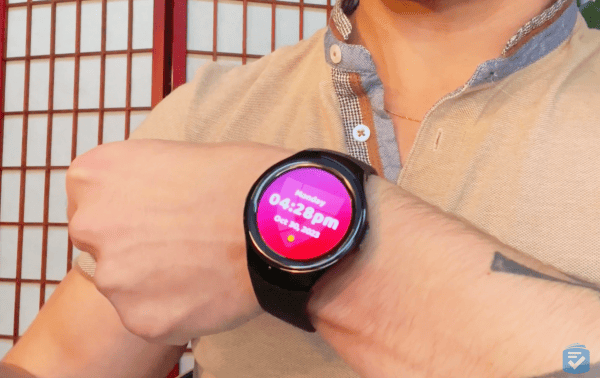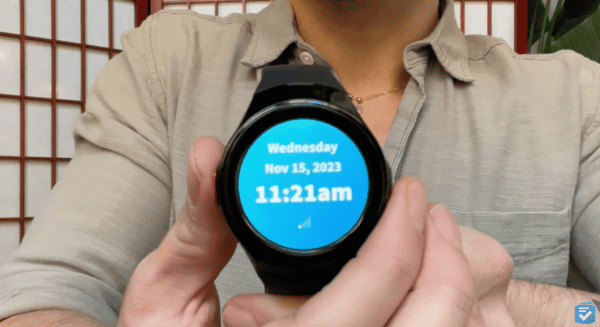The Best Smartwatches for Seniors in 2025
Smartwatches have become an increasingly popular wearable technology, offering a wide range of features that can enhance the lives of seniors. From fitness tracking and health monitoring to fall detection and emergency alerts, smartwatches can help seniors stay safe, active, and connected.
No two seniors are identical; however, when choosing a smartwatch for seniors, it’s important to consider a person’s needs and tech literacy. While the latest smartwatches from Samsung and Apple can provide detailed information on one’s blood oxygen levels and heart rate, they might come with a steep learning curve. Additionally, these devices lack some of the safety features found on medical alert watches.
>> Read more: Best Medical Alert Watches
In this guide to the best smartwatches for seniors, we’ll recount our experience testing a number of smartwatches popular among older adults. We’ll highlight their key features, benefits, and drawbacks, and we’ll also explain their pricing.
Best Smartwatches for Seniors in 2025
- MGMove Watch : Best Smartwatch Overall
- SOS Smartwatch : Best Smartwatch With GPS
- UnaliWear Kanega Watch : Best Smartwatch for Battery Life
- Apple Watch SE : Best Smartwatch for Health Monitoring
>> Learn more: The Best Medical Alert Systems Overall
Senior Smartwatches Compared
| MGMove | SOS Smartwatch | Kanega Watch | Apple Watch SE | |
|---|---|---|---|---|
| Watch price | $199.95 | $159 | $299 | $249 |
| Monthly cost | $39.95 | $34.95 | $69.95 | Requires extra cellular plan |
| Average emergency response time | 10 | 16 | 30 | N/A |
| Extra features |
|
|
|
|
Our Methodology
To create this list, we tested over a dozen smartwatches suggested by our readers. Here’s how we evaluated and ranked them:
- Emergency response features: For every watch with emergency response features, we placed five test calls and calculated a mean average response time.
- Accurate GPS: We tested each watch’s GPS for accuracy.
- Health tracking: We gave extra points to smartwatches that included health tracking features like heart rate monitors, pedometers, and blood oxygen meters.
- Durability: We tested every watch for water resistance and its ability to withstand falls.
- Affordability: Generally, a smartwatch will have two costs: the watch itself and a monthly subscription charge. We weighed pricing when compiling our rankings.
- Extra features: From automatic fall detection to voice commands to text messaging, we also accounted for watches with unexpected bonus features.
>> Read more: The Best Fall Detection Devices
Our Top Picks
1. MGMove Watch - Best Smartwatch Overall
What We Like Most:
- Ultra-fast emergency response time
- Location tracking for caregivers
- Step-counting app IP67 water-resistance
Overview

Medical Guardian has long been one of our favorite medical alert providers, and its latest smartwatch, the MGMove, lives up to the company’s name. Combining an urgent response feature with communicative apps for caregivers, this watch is one of the best smartwatches for seniors.
>> Read more: Medical Guardian Review
Performance
Out of all the smartwatches I’ve tested, the MGMove had the quickest response time: just 10 seconds. While the difference between 10 and 30 seconds — the longest response time, from the Kanega Watch — may not seem like a lot, every second counts in an emergency situation.

Features
The main features of the MGMove are urgent response calls, weather information, step counting, and a messaging app, which allowed me to chat with my friends and family through text and voice messages.
The MGMove also has a reminder feature. With this, I could log in to the Medical Guardian portal (available on smartphones and computers) and schedule reminders on the MGMove. For example, I set a daily 8 a.m. reminder to take my medication. Each morning, my watch would vibrate at 8 a.m., reminding me to take the medication.
Costs
The MGMove device itself costs $199.95, which is pretty average when it comes to smartwatches. Then, you’ll pay $39.95 per month for your monthly subscription. Unfortunately, if you want the messaging and reminder features to be enabled on this watch, you’ll have to pay an additional $5 per month.
>> Learn more: Medical Guardian Costs
Drawbacks
Surprisingly, the MGMove lacks fall detection, so if you fall and you’re unable to press the emergency button or message a friend or family member, you may not be able to get the help you need. If fall detection is a must for you, then we’d recommend checking out the SOS Smartwatch, our next entry.
Our Verdict
The MGMove combines the communication features of a smartwatch with the safety features of a medical alert device, giving users a highly useful device. If fall detection is not needed, then this option may be your best choice.
To learn more about this watch, read our full MGMove review.
Pros
- Quick response time
- Messaging features
- Useful app for caregivers
- Water-resistant
Cons
- No fall detection
2. SOS Smartwatch - Best Smartwatch With GPS
What We Like Most:
- 4G LTE and GPS connection
- Water-resistant design
- Accurate fall detection
- No long-term contracts
Overview

Bay Alarm Medical is one of the most trusted medical alert companies, so naturally, when the company came out with a smartwatch, I was intrigued. Its SOS Smartwatch combines all the features of a GPS medical alert with the sleek profile of a modern smartwatch. It even includes fall detection for an extra monthly fee.
>> Further reading: Bay Alarm Medical Review
Performance
In our tests, the SOS Smartwatch had the second-fastest response time, with our calls being answered in an average of 16 seconds. Given the average for the group was about 19 seconds, it gets in at just below that, providing quick emergency services when I need them. Additionally, because the watch uses a 4G LTE network, I had fast speeds.
Features
The SOS Smartwatch had all of the features I’d expect from a smartwatch, like a dedicated SOS button, weather information, step counting, and fall detection. Because the watch comes with GPS built in, when I pushed the SOS button as a test, the Bay Alarm monitoring center was able to accurately report my location, whether it was in my home or by the local train station.
Costs
The SOS Smartwatch costs $159, followed by a monthly subscription charge of $34.95. If you want to add fall detection, you’ll have to pay an additional $10 per month. In our experience, this feature was worth it. In our test falls, the SOS Smartwatch was able to accurately detect 90 percent of them.
>> Read more: Bay Alarm Medical Pricing
Drawbacks
While the SOS Smartwatch can last up to 18 hours without needing a charge, in theory, I found that it lasted only six hours when I was using it more. This is pretty disappointing battery life, especially compared to the Kanega Watch, which lasted 32 hours on a single charge.
Our Verdict
The SOS Smartwatch is one of the safest choices on this list, with the fastest response time: just 16 seconds. The only drawback is the relatively short battery life, which ranges from six to 18 hours. If you want longer battery life, check out the Kanega Watch, which also has fall detection.
To learn more about this smartwatch, read our full SOS Smartwatch review.
Pros
- 4G LTE data
- Step-counting feature
- Accurate GPS location tracking
- No long-term contract required
Cons
- No communication features with caregivers
3. UnaliWear Kanega Watch - Best Smartwatch for Battery Life
 View Packages
Links to UnaliWear Kanega Watch
View Packages
Links to UnaliWear Kanega Watch
What We Like Most:
- Accurate fall detection included
- 4G LTE signal from Verizon
- 32 hours of battery life
- Voice-activated emergency calls

Overview

Not only does the Kanega Watch have the longest battery life of any smartwatch I’ve tested (32 hours, to be specific), but it also features a unique system of multiple batteries that allowed me to keep wearing the watch, even while its batteries were charging. This, combined with its accurate fall detection, made the Kanega Watch one of our favorite devices.
Performance
While the Kanega Watch did have the longest response time of any watch on this list — an average of 30 seconds — this is still pretty fast among medical alert systems. For example, Life Alert took an average of two minutes to answer our test calls.

>> Read more: Life Alert Review
Elsewhere, I was impressed by the accuracy of this watch’s GPS and the volume of its speakerphone. When I placed a test call outside on a windy day, I was still able to hear the response agent tell me that my call was placed outside the Dunkin Donuts on Barton Street.
Features
The Kanega watch allowed me to make an emergency call in three ways:
- Pressing the side button
- Automatic fall detection
- Voice command
To make a call using my voice, I had to say the wake words: Fred Astaire. Once I said this, I could tell my watch to place an emergency call and it would do so. While I found it somewhat awkward to say “Fred Astaire” out loud, I could see this feature being useful.
Another way the watch stood out was its “quick-swap” rechargeable batteries. While all of the smartwatches on this list have rechargeable batteries, the Kanega is the only option with extra batteries in the charger. When my watch ran out of juice after three days (the longest battery life on this list), I didn’t have to take it off and wait for it to charge. Rather, I simply swapped the batteries with the ones in the charger, ensuring that my watch could stay on 24/7.
Costs
There’s no way around it. The Kanega Watch is costly. This watch costs $299, followed by a monthly $69.95. While these prices can be reduced if you pay annually as opposed to monthly, I can’t imagine many seniors would want to pay nearly $1,000 upfront for a medical alert watch.
Drawbacks
High costs aside, the Kanega watch also lacks caregiver connectivity. While the watch can use medication reminders — which you set up over the phone — it does not have any type of messaging or location-tracking features for caregivers. If these features appeal to you, then I’d recommend the MGMove watch.
Our Verdict
While it is relatively simple and costly, the Kanega Watch has a great battery life and an intuitive design. We should also mention its fall detection was particularly accurate. If budget is not your top concern, then this may be a good option for you.
To learn more about this watch, read our full Kanega Watch review.
Pros
- IP67 water-resistance
- Voice-activated calling
- Long-lasting battery
- 30-second average response time
Cons
- $70 per month
- High upfront costs
4. Apple Watch SE - Best Smartwatch for Health Monitoring

What We Like Most:
- Highest number of band materials, colors, and designs
- Heart rate and sleep monitoring
- Data from T-Mobile, Verizon, or AT&T
- Fall detection and emergency SOS
Overview
The Apple Watch SE is the Cadillac of smartwatches, encompassing the powers of both a medical alert device and a souped-up smartphone. From my Apple Watch, I could FaceTime friends, receive text messages, log my heart rate and sleep cycles, and do other things. The primary downside is that you’ll need a separate cellular connection to use this watch.
>> Read more: The Best Smartphones for Seniors
Performance
First things first: The Apple Watch does not have urgent response calling like the other smartwatches on this list. Although it does have an emergency response button and fall detection, placing calls with these will, by default, call 911. With this in mind, I could not place test calls on my Apple Watch.

That said, I could test its fall detection, which worked pretty well, accurately detecting eight of my 10 test falls. Additionally, I appreciated that I could adjust the fall detection feature to contact my mother instead of 911. This could be very useful for people with loved ones nearby.
Features
The Apple Watch, aside from having automatic fall detection and an emergency SOS button, has the most health features of any smartwatch on this list (or on the market generally.) Take sleep monitoring, for example, which only the SE has among the watches on this list. Because I was feeling tired during the day, I used the sleep monitoring to break down exactly how many minutes I was spending in REM, deep sleep, and core sleep.
I found out I was waking up multiple times per night, and the watch even gave me trends over the past two weeks. To improve my energy and mood, I set a sleep goal and turned on Sleep Focus Mode, which turned off the watch’s display around bedtime. I found that not using my device close to bedtime helped improve my sleep, giving me higher energy levels throughout the day.
Costs
The Apple Watch SE costs as little as $249 for the 40 mm version with a rubber wristband. If you want the larger, 44 mm watch face or a stainless steel band, then you’ll have to pay more.
You’ll also want to factor in the cost of your service. With an Apple Watch, you have two options. If you have an iPhone, then your watch can piggyback off the service of your iPhone at no extra cost. If, however, you want your Apple Watch to work without an iPhone nearby, then you can purchase an additional cellular line. For example, Verizon currently charges $10 per month to add an Apple Watch to your existing plan.
>> Read more: The Best iPhones for Seniors
Drawbacks
The biggest drawback of the Apple Watch SE — as well as Apple’s products in general — is the price. Even the lowest-cost option, the 40 mm watch with a rubber wristband, costs $249, which is about $50 more than the second-most-expensive option, the MGMove. Not to mention that using the SE requires an iPhone, which, if you don’t already have one, can range from $429 to $999 or more if you buy a new device. Apple certainly isn’t the most affordable option, although you get what you pay for in terms of features.
Our Verdict
If you have a larger budget and want some features you don’t get with any other watch, like sleep monitoring, the Apple Watch SE could be for you. It’s a great choice for someone already in the Apple ecosystem who owns an iPhone and doesn’t mind paying a little more for a more advanced device. However, if you don’t want to shell out nearly $250 for the device alone, more affordable options are the SOS Smartwatch.
Pros
- Sleep and heart rate monitoring
- Integration with iPhone
- Choose from Verizon, T-Mobile, or AT&T
- Emergency SOS and fall detection
Cons
- Requires an iPhone
- Most expensive equipment
What Seniors Should Look for in a Smartwatch
When you are shopping for a smartwatch, here are some features to keep in mind.
Ease of Use
A smartwatch should have a touch screen and be intuitive to use, whether or not it requires a smartphone. If you can, test out a smartwatch at a store like Best Buy.
Medical Alert Features
The medical alert features you should look for include:
- GPS: The reason that most smartwatches require a monthly subscription is for the data that GPS requires. It’s similar to the fees you’d pay to a cell phone company for its cellular data service. Without GPS, emergency help may not be able to find you.
- Fall detection: In contrast to medical alert pendants, which can be bulky and unattractive, smartwatches with fall detection let you receive the benefits of a medical alert pendant in a more unobtrusive form. With automatic fall detection, a watch can tell if you’ve had a fall and can contact emergency services for you without your having to push a button.
- Urgent response calling: The watch must connect to a 24/7 monitoring center, which can either respond when you push the SOS button or when you fall. I look for companies with U.S.-based, UL-certified monitoring centers.
Health Features
These are the most common health features of the smartwatches I’ve worn:
- Step counting: Getting outside and walking is a great way to stay in shape. To keep track of your progress, some smartwatches have built-in pedometers that will tell you when you’ve met your daily step goal.
- Heart rate monitoring: More advanced smartwatches like the Apple Watch SE will monitor your heart rate, which could be helpful for someone with heart issues.
- Sleep monitoring: Additionally, these more technologically advanced watches, like the Apple Watch SE, can even monitor your sleep, telling you how much time you spend in REM each night and helping you meet your sleep goals.
Comfort, Size, and Weight
You want a watch that’s comfortable to wear, as most people wear their smartwatches 24/7. Most bands are made from either rubber, plastic, or fabric, and they come in a variety of sizes for different wrists. Smartwatch wristbands are measured in inches, typically, and range from about five to nine inches. The watch should sit snugly on your wrist without cutting off your circulation. You should not feel any strain from wearing the watch, which is why it’s important that it’s made of a lightweight material.
Apple Watch vs. Medical Alert Watches
The Apple Watch SE is the only smartwatch on this list that’s not technically a medical alert watch. Rather, it’s a smartwatch that has the features of a medical alert device, like fall detection and emergency SOS. For example, when I was wearing the Apple Watch SE and staged a fall, the watch buzzed on my wrist, sounded an alarm, and alerted me that it thought I had taken a fall.
>> Read more: Best Medical Alert Watches
It also gave me the SOS emergency call button. From there, I could’ve chosen to push the button to get connected to emergency services or dismissed the alert by tapping “I’m OK.” This feature can be turned on or off, although I recommend leaving it on, as falls are a big health risk for seniors.
Additionally, with the SOS button, I could make a call to local emergency services and the watch would share my location with them, similar to most smartwatches with GPS, like the MGMove. This feature requires either a cellular connection or Wi-Fi.
Essentially, the Apple Watch has all of the features of a medical alert watch plus a lot more, like sleep monitoring, more workout metrics, and the ability to receive texts. However, it’s much more expensive than most medical alert watches, which range from $120 to $200. The Apple Watch SE starts at $249 and can be as expensive as $579, based on wristband material, size, and design. If you want a medical alert watch for less, Apple Watches are not the best choice for you. They’re also available only to those with an iPhone, which isn’t the case for medical alert watches, which work independently of other devices.
Recap
A smartwatch is a great way to stay safe on the go, without making it evident that you’re wearing a medical alert device. According to the Centers for Disease Control, 1 out of every 4 adults age 65 and older falls every year in the U.S., resulting in over 32,000 deaths. With a comfortable device that can detect falls and contact emergency services for you, you can reduce the likelihood of this worst-case scenario.




